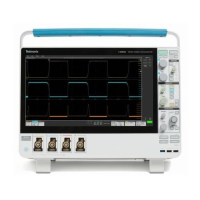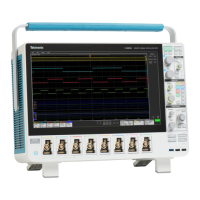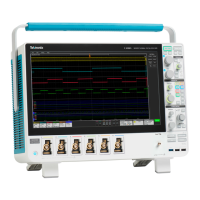Command Syntax
Numeric
Many oscillosc
ope commands require numeric arguments. The syntax shows
the format that the oscilloscope returns in response to a query. This is also the
preferred format when sending the command to the oscilloscope, though any of
the formats will be acce pted. This documentation represents these arguments as
described below.
Table 2-14: Numeric Arguments
Symbol Meaning
<NR1>
Signed integer value
<NR2> Floating point value without an exponent
<NR3> Floating point value with an exponent
<bin>
Signed or unsigned integer in binary format
Most numeric arguments will be automatically forced to a valid setting, by either
rounding or truncating, when an invalid number is input, unless otherwise noted
in the c
ommand description.
Quoted String
Some commands accept or return data in the form of a quoted string, which is
simply a group of ASCII characters enclosed by a single quote (') or double quote
("). T
he following is an example of a quoted string:
"This i s a quot ed
string"
. This documentation represents these arguments as follows:
Table 2-15: Quoted String Argument
Symbol Meaning
<QString> Quoted string of ASCII text
A quoted string can include any character defined in the 7-bit ASCII character
se
t. Follow these rules when you use quoted strings:
1. Use the same type of quote character to open and close the string. For
e
xample:
"this is a valid string".
2. You can mix quotation marks within a string as long as you follow the
previous rule. For example:
"this i s an 'acc eptable' string".
3. You can include a quote character within a string by repeating the quote. For
example:
"here is a "" mark".
4. Strings can have upper or lower case characters.
5. A carriage return or line feed embedded in a quoted string does n ot terminate
the string. The return is treated as another character in the string.
6. The m aximum length of a quoted string returned from a query is 1000
characters.
2-8 MSO54, MSO56, MSO58, MSO58LP Programmer

